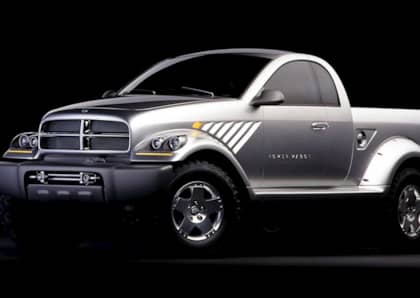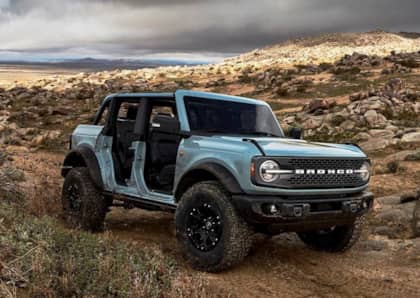3 Platform-Sharing SUVs That Were Never Built (And What We Got Instead)
What's more interesting than a shiny new truck toy, especially if you see it in the hands of your rival across the hall? This has often been the guiding philosophy of automotive design as divisions fought each other tooth-and-nail for access to the latest platforms and technologies when building pickups and SUVs.

Much of the time a compromise is found and the same chassis and drivetrain are shared between multiple brands operating under the same roof. That being said, there are still occasions where one automaker asserts its dominance and claims a platform all on its own. In still other cases, there simply isn't enough room in the budget, or at the factory, for a platform to sprout more than one SUV or truck.
These 3 platform sharing SUVs might never have been built, but the story of how they came into being and the circumstances surrounding them is just as interesting as any other sport-utility origin story.
Third-Generation Dodge Ramcharger
What Was It?
In the early '90s Dodge had an SUV problem. The Jeep Cherokee XJ had been a smash hit, General Motors was raking in cash with its similar-sized Blazer/Jimmy combination, and rumor had it Ford was about to change the game with a mid-size four-door sport-utility called the Explorer. The Pentastar, on the other hand, had nothing other than the aging Dodge Ramcharger, a two-door hauler that was nearing the end of its useful life.

Lurking in the wings, however, was the ZJ platform. This was a plus-size version of the XJ's underpinnings that had been intended to provide Jeep with a larger SUV to sell alongside the Cherokee, called the Grand Cherokee. Once Jeep had been brought into the Chrysler fold following its 1987 purchase, Dodge execs went wild with envy and demanded a version of the ZJ platform for the brand. The company even went so far as to create a full mock-up of what the ZJ-based vehicle would look like, ostensibly to be branded with the Ramcharger name.
Why Was It Never Built?
Chrysler had a big fight on its hands over the ZJ platform.

Top brass decided to hear from each design team to make their best argument for why they deserved the vehicle, as the company couldn't afford to build an SUV of this size for both. In the end, Jeep won CEO Lee Iacocca's heart, and the rest is Grand Cherokee history.
What Did We Get Instead?
Dodge's dream of a mid-size SUV wasn't dead, but it was definitely headed in a very different direction. Rather than make use of a unibody design like the ZJ, Dodge would snag the full-frame from underneath the Dakota pickup and re-body it as the Durango in 1998.

The three-row Durango would go on to sell hundreds of thousands of examples for Dodge, making for a deferred reward after having been SUV-spurned. A true third-generation Ramcharger based on the full-size Ram pickup would also appear in the Mexican market for a brief window at the end of the '90s.
Chevrolet K5 Concept
What Was It?
By 2001, GM had fully moved away from the GMT 400 truck platform, which meant the end of both the two-door Chevrolet Tahoe and the GMC Yukon GT (with the Tahoe and the Yukon now four-door only). Fans of SUV coupes got one last two-door tease at the Detroit auto show that same year with the Chevrolet K5 Concept.

The K5 Concept was built on the GMT 800 chassis used by each and every full-size SUV and pickup built by General Motors at that time. From the A-pillar forward it was the same as any other Tahoe, but behind the front door sat a smaller, rear-hinged opening that was connected to a diagonal sail panel much like that of the Chevrolet Avalanche. The rear seat passengers were semi-exposed to the elements, although not as out in the open as with the original K5 Blazer.
Why Was It Never Built?
Chevrolet had built several two-door Tahoes for testing purposes using the GMT800 platform, but none of them every saw production. Four-door models were much, much more popular with the family demographic that made up most Tahoe/Yukon sales, and it was hard to justify diverting assembly line capacity to a slow-selling design.

Throw in the modifications that would have to be made to support a convertible version (the concept had no rear top whatsoever), and there was no business case to be made for the K5 Concept.
What Did We Get Instead?
Part of the reasoning behind the shorter-wheelbase K5 Concept was to give off-road fans a more nimble option on the trail.

And yet, it would be four more years before GM would produce the Hummer H3, its only mid-size dedicated 4x4. With a wheelbase of 112 inches it matched the K5 Concept exactly, although it was four inches narrower than its full-size predecessor.
Mercury Meta One
What Was It?
Mercury was always on the outside looking in when it came to an SUV of its own, with the Mountaineer and the Mariner simply carbon copies of the Ford Explorer and the Ford Escape. It tried to change that in 2005 with the Mercury Meta One concept, a vehicle that shared its roots with the D3 platform used by the Ford Freestar/Taurus X but which walked its own path everywhere it counted.

The biggest change was its twin-turbo diesel V6, a 2.7L unit that was part of a hybrid drivetrain making use of a single electric motor. Total torque for the setup was a generous 431 lb-ft, and the vehicle was intended to keep emissions lower than with most diesel SUVs due to its hybrid design.
Why Was It Never Built?
With a couple of years the world would plunge headlong into financial crisis, and that would spell the end of Mercury as a brand.

Although prototypes of the Meta One had been spotted testing in Michigan just prior, by 2008 Ford had already decided to stop developing new Mercury models and production plans were dropped.
What Did We Get Instead?
The black, black emptiness of the void: Mercury ceased to exist after 2010, with the final Grand Marquis built in January the following year.

More From Driving Line
- Jeep had more than its fair share of forgotten concepts. Check out the Jeep SUVs that were never built, and find out what was sold in their place.











